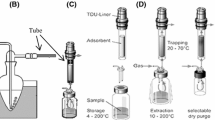Abstract
Lipid oxidation is one of the most detrimental processes in food, occurring during production and storage, and influences food aroma and taste. Analysis of volatile lipid oxidation products provides an insight into the oxidation and some volatiles, such as hexanal can be markers of undergoing oxidation processes. A method for hexanal determination in oil, potato chips, and mayonnaise matrices with high fat content was developed. Water was used as a matrix for comparison of performance of oil, emulsion, or nonhomogenous matrix in hexanal release. Sample weight, mixing with water, equilibrium temperature, and time were determined for each matrix to provide the highest extraction efficiency. The developed method is characterized by detection limits of 0.06, 0.07, and 0.09 mg/kg for rapeseed oil, potato chips, and mayonnaise, respectively, and linearity for all matrices was 0.999 for a range of 0.1–50 (potato chips) or 200 mg/kg (rest of matrices). Repeatability of the method was in a range of 3.11–5.43 % and intermediate precision of 3.59–5.96 % depending on a fat-rich product analyzed. The developed method presents an easy and automated approach to determine hexanal as a marker for lipid oxidation in oils and high fat products.




Similar content being viewed by others
References
Beliz HD, Grosch W, Schieberle P. (2009) Food chemistry 4th edition. Springer-Verlag, Berlin Heidelberg
Boque R, Vander Heyden Y (2009) The limit of detection. LCGC Europe
Cavalli JF, Fernandez X, Lizzani-Cuvelier L, Loiseau AM (2003) Comparison of static headspace, headspace solid phase microextraction, headspace sorptive extraction, and direct thermal desorption techniques on chemical composition of French olive oils. J Agric Food Chem 51:7709–7716
Choe E, Min DB (2006) Chemistry and reactions of reactive oxygen species in foods. Crit Rev Food Sci Nutri 46:1–22
Cognat C, Shepherd T, Verrall S, Stewart D (2012) Comparison of two headspace sampling techniques for the analysis of off-flavour volatiles from oat based products. Food Chem 134:1592–1600
Dupuy HP, Flick GJ, Bailey ME, St. Angelo AJ, Legendre MG, Sumrell G (1985) Direct sampling capillary gas chromatography of volatiles in vegetable oils. J Am Oil Chem Soc 62:1690–1693
Frankel EN, Hu ML, Tappel AL (1989) Rapid headspace gas chromatography of hexanal as a measure of lipid peroxidation in biological samples. Lipids 24:976–981
Garcia-Llatas G, Lagarda MJ, Romero F, Abellan P, Farre R (2006) A headspace solid-phase microextraction method of use in monitoring hexanal and pentane during storage: Application to liquid infant foods and powdered infant formulas. Food Chem 101:1078–1086
Gromadzka J, Wardencki W (2010) Static headspace sampling and solid-phase microextraction for assessment of edible oils stability. Chromatographia 71(Supplement):81–86
Huber L. (2010) Validation of analytical methods. A primer. Agilent Technologies. Publication number 5990-5140EN
ICH Harmonised Tripartite Guideline. Validation of analytical procedures: text and methodology Q2(R1) (2005)
Jacobsen C, Meyer AS, Alder-Nissen J (1999) Oxidation mechanisms in real food emulsions: oil–water partition coefficients of selected volatile off-flavor compounds in mayonnaise. Z Lebensm Unters Forsch A 208:317–327
Jeleń H, Wasowicz E (2012) Lipid derived flavor compounds. In: Jelen H (ed) Food flavors: Chemical, sensory, and technological properties. CRC Press, Boca Raton, pp 65–94
Jeleń HH, Mildner-Szkudlarz S, Jasińska I, Wąsowicz E (2007) A headspace–SPME–MS method for monitoring rapeseed oil autoxidation. J Am Oil Chem Soc 84:509–517
Kaykhaii M, Rahmani M (2007) Headspace liquid phase microextraction for quantitation of hexanal in potato crisps by gas chromatography. J Sep Sci 30:573–578
Kochhar SP. (1996) Oxidative pathways to the formation of off-flavours. In: Saxby MJ (ed) Food taints and off-flavours. Blackie Academic & Professional, New York, p 168–225
Mandić AI, Sedej IJ, Sakač MB, Mišan AČ (2013) Static headspace gas chromatographic method for aldehyde determination in crackers. Food Anal Methods 6:61–68
Muriel E, Andres AI, Petron MJ, Antequera T, Ruiz J (2007) Lipolytic and oxidative changes in Iberian dry-cured loin. Meat Sci 75:325–333
Pastorelli S, Torri L, Ridriguez A, Valzacchi S, Limbo S, Simoneau C (2007) Solid-phase micro-extraction (SPME-GC) and sensors as rapid methods for monitoring lipid oxidation in nuts. Food Addit Contam 24:1219–1225
Romeu-Nadal M, Castellote AI, López-Sabater MC (2004) Headspace gas chromatographic method for determining volatile compounds in infant formulas. J Chromatogr A 1046:235–239
Sanches-Silva A, Rodríguez-Bernaldo de Quirós A, López-Hernández J, Paseiro-Losada P (2004) Determination of hexanal as indicator of the lipidic oxidation state in potato crisps using gas chromatography and high performance liquid chromatography. J Chromatogr A 1046:75–81
Shahidi F. (1998) Indicators for evaluation of lipid oxidation and off-flavor development in food. In: ET Contis et al. (eds) Food flavors: formation, analysis and packaging influences. Elsevier, Amsterdam, The Netherlands
Shahidi F, Yun J, Rubin L, Wood DF (1987) The hexanal content as an indicator of oxidative stability and flavor acceptability in cooked ground pork. Can Inst Food Sci Technol J 20:104–106
Vichi S, Pizzale L, Conte LS, Buxaderas S, López-Tamames E (2003) Solid-Phase Microextraction in the analysis of virgin olive oil volatile fraction: modifications induced by oxidation and suitable markers of oxidative status. J Agric Food Chem 51:6564–6571
Waraho T, McClements DJ, Decker EA (2011) Mechanism of lipid oxidation in food dispersions. Trends Food Sci Technol 22:3–13
Acknowledgments
Work was financed under a project NCN (National Science Center) 2012/07/B/NZ9/01634.
Compliance with Ethic Requirements
This work did not contain any studies with animal or human subjects.
Conflict of Interest
Mohammad Hassan Azarbad declares that he has no conflict of interest. Henryk Jeleń declares that he has no conflict of interest.
Author information
Authors and Affiliations
Corresponding author
Rights and permissions
About this article
Cite this article
Azarbad, M.H., Jeleń, H. Determination of Hexanal—an Indicator of Lipid Oxidation by Static Headspace Gas Chromatography (SHS-GC) in Fat-Rich Food Matrices. Food Anal. Methods 8, 1727–1733 (2015). https://doi.org/10.1007/s12161-014-0043-0
Received:
Accepted:
Published:
Issue Date:
DOI: https://doi.org/10.1007/s12161-014-0043-0




